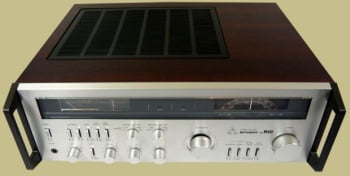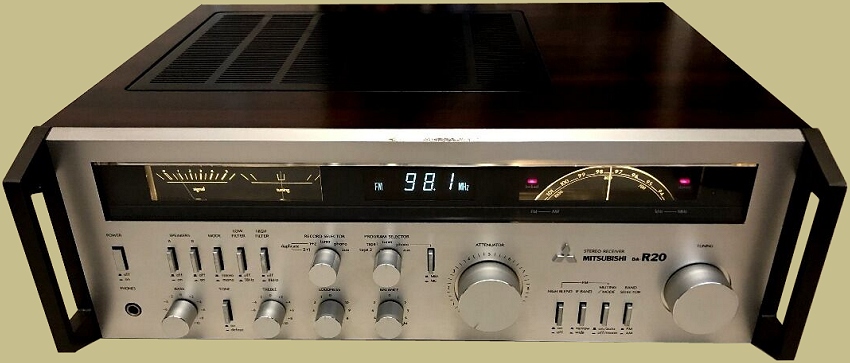
The Mitsubishi DA-R20 receiver debuted in 1980 at a retail price of $560. It was Mitsubishi’s first foray into receivers. Previously they had only built separate components. The DA-R20 is a hybrid design with some analog features and some digital features. The tuner actually has both a digital LED frequency readout as well as an interesting hemispherical analog dial scale. The dark cabinet, brushed aluminum face and industrial style rack handles give it an elegant but utilitarian look. At first glance it almost looks like a piece of test equipment.
Mitsubishi leveraged their expertise in high-end separate components when designing the DA-R20. Rather than compromise on critical circuits, they reduced costs by eliminating non-essential features.
The goal was to build a receiver with the performance of separate units costing much more. To do this, they used proven circuit topologies and quality parts from their separate models. While not inexpensive compared to other receivers at the time, the DA-R20 delivered high performance and value at a reasonable cost.
The DA-R20 was at the top of Mitsubishi’s first receiver lineup. The other models included the 45 wpc DA-R10 and the 30 wpc DA-R7.

Front Panel
Mitsubishi’s DA-R20 receiver incorporated a sophisticated tuning mechanism that allowed precise frequency selection across the FM band. The tuning knob takes 15 full rotations to traverse the entire FM spectrum, enabling tuning resolution down to 100 kHz increments. This fine-tuning capability complements the digital frequency display at the center of the panel, which shows FM frequencies to 100 kHz and AM frequencies to 1 kHz precision.
The dual tuning displays – analog dial and digital readout – offer the best of both worlds for usability on the DA-R20. The digital numbers give an exact frequency, while the rotating dial provides a tactile experience and easy visual scanning.
An automatic frequency control (AFC) system locks onto stations to ensure tuning accuracy and is indicated by an LED near the tuning knob on the unit. Another LED indicates when you have stereo reception.
The lower section of the DA-R20’s front panel contains additional controls like power, speaker selection, stereo/mono mode, bass and treble tones, and input selection. There are separate knobs for recording source and listening source, enabling tape dubbing capabilities. The phono input accommodates both moving magnet and moving coil cartridges which are selectable via push button.
Design touches for usability on the Mitsubishi receiver include balance and loudness controls, plus a master volume calibrated from 0 to 10. Further controls between the volume knob and tuning dial provide advanced functions like high blend, muting, and AM/FM band toggle.
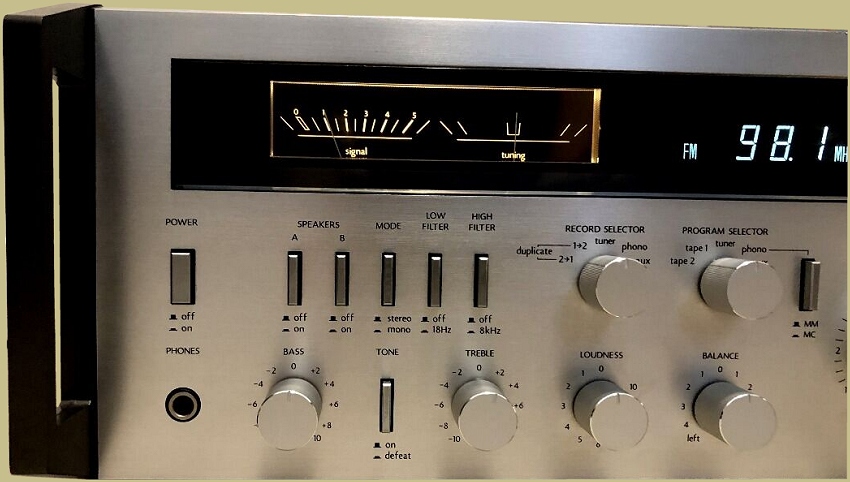
Tuner
The tuning section in Mitsubishi’s DA-R20 is pretty good. Here are some of its features:
- It uses special dual-gate FET transistors in the radio frequency (RF) amplifier and mixer stages. These provide excellent sensitivity and selectivity when receiving weak stations.
- The intermediate frequency (IF) filters are high quality ceramics that allow switching between wide and narrow bandwidths. This gives flexibility in tuning crowded signals.
- For FM stereo decoding, a phase locked loop (PLL) system is used. This includes a pilot canceller circuit to reduce noise in the stereo separation.
- FM detection uses a quadrature detector with a transformer. This gives very linear stereo separation across the audio band.
- Having separate IF stages for wide and narrow modes optimizes each path for its function. Narrow IF strips maximize selectivity, while wide IF strips optimize fidelity.
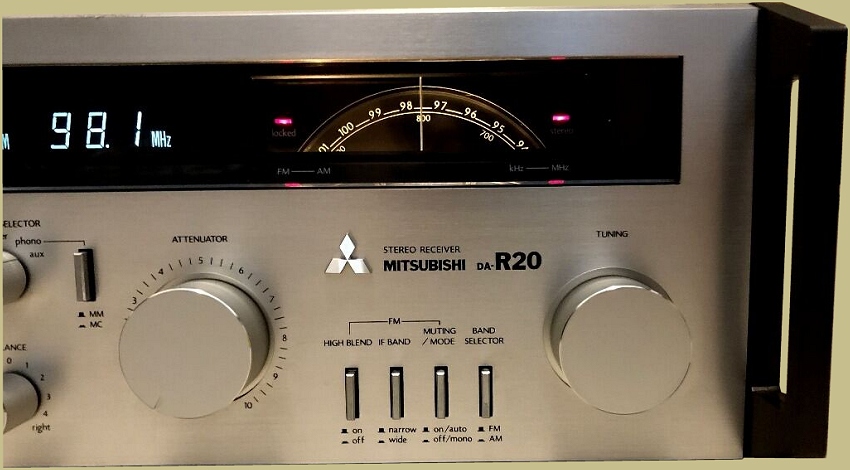
Specifications
Here are the specs for the DA-R20:
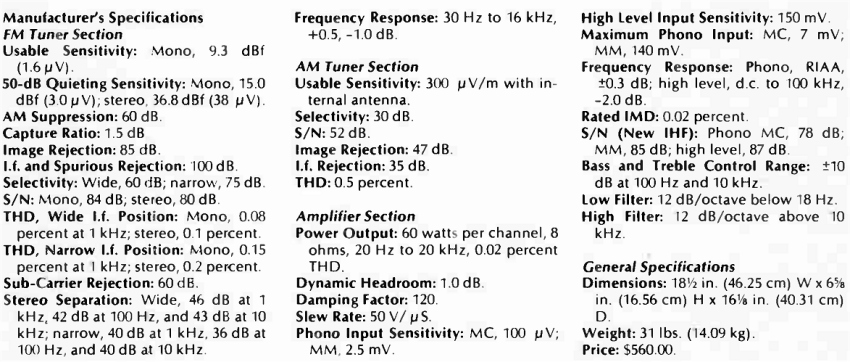
Amplifier
The amp in the DA-R20 produces a rated output of 60 watts per channel into 8 ohms. Here are some of its other features:
- It has a dedicated preamp for moving coil cartridges, giving extra amplification for MC’s lower output.
- Multiple gain stages with negative feedback ensure low distortion and noise.
- The tone controls use a DC-coupled design for smooth response.
- The power amp is also DC-coupled end-to-end for transparency.
- Speaker selection uses relays for precise matching.
- Protection circuits guard against faults and turn-on pops.
- In testing, the power amp delivered 87 watts per channel – far above its 60 watt rating.
- The amp’s wide power bandwidth and high damping factor give excellent speaker control.
- Dynamic headroom measured a very high 2.6dB, despite the conservative 1dB spec.
- Phono stages provide suitable gain and overload margins for MC and MM cartridges.
- Noise and sensitivity meet or exceed expectations across all inputs.
- RIAA EQ is highly accurate, and high-level response is ruler-flat to 95kHz.
Overall, the amplifier’s specs are very good. Some users, however, have noted that the DA-R20 tends to sound a little sterile. Hi-Fi Stereo Review said of the DA-R20’s amplifier:
“The distortion and noise levels of the amplifiers in the DA -R20 are not only among the lowest we have encountered, but they are actually realized under most operating conditions. From the lowest useful output to well beyond maximum ratings, and at any frequency in the audio range, the amplifier distortion is barely measurable.“
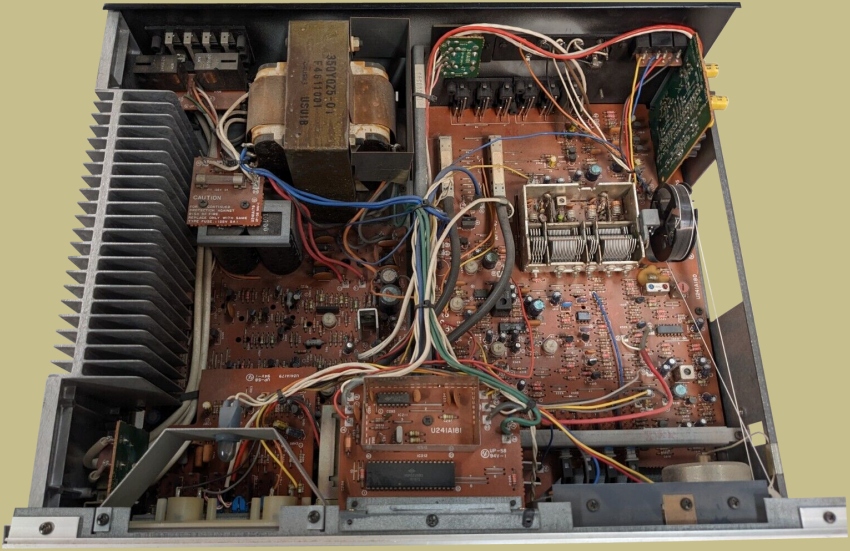
There are a couple issues that come up with the DA-R20. The STK 1060 output power packs can fail resulting in loss of a channel or other erratic behavior. The DA-R20 uses two of them that are easily accessible with the cover off.
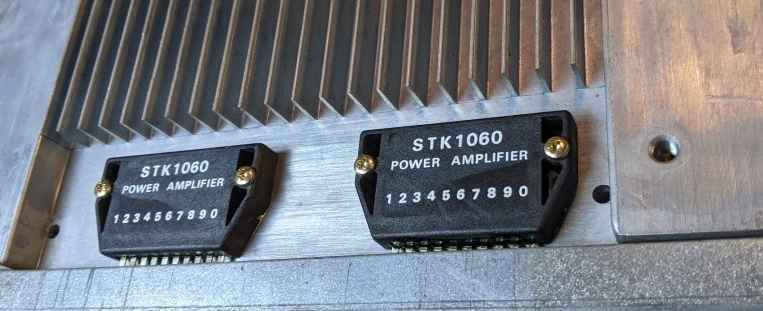
Fortunately you can still find some of the original STK1060’s around. In fact, there is someone on eBay selling new custom STK1060’s that are better than the originals. They are more expensive than some of the ‘new’ options out there but here’s what one buyer said about them:
“Replacing some counterfeit/repo stk1060 modules that lasted 6 hours. Do yourself a favor and pay the extra $ for these from pyramid audio in Austin TX. Installed in a Mitsubishi da-r20. Working great.“
There is also an integrated chip that controls the digital display which can fail (MSL2318). They are sometimes available on eBay HERE.
Rear Panel
The DA-R20’s rear panel provides connections for various audio sources and external components. Standard ports include AM/FM antenna terminals, a phono input, an auxiliary input, and two tape in/out jacks for recording and playback.
For flexible system expansion, the DA-R20 has preamplifier outputs and main amplifier inputs. Rather than needing manual jumpers or switches, these circuits automatically disconnect when cables are inserted, thanks to clever jack design. This enables easy separation of preamp and power amp stages when desired.
Speaker connections are well isolated on the opposite side of the rear panel area. The DA-R20 provides two pairs of color-coded, spring-loaded speaker terminals for main and remote speaker hookup.
Convenience AC outlets – one unswitched and two switched – allow easy power connection for other system components. Fuse holders and circuit breakers are not located on the rear panel, but are internal to the unit.

The Mitsubishi DA-R20 certainly looks great. It’s performance isn’t bad either. While its specs are excellent it does have a reputation a sounding a little dry but that’s mainly due to its very flat frequency response curve. If you like true reproduction of sound without coloration then you might like its sound. It also has some common circuitry issues that can be problematic – but they are solvable. So, if you find a DA-R20 in good working condition it might be worth checking out. It would certainly look good in any audio setup.
